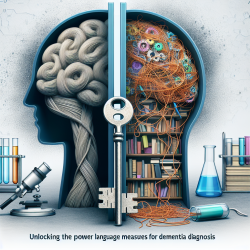Introduction
As a Special Education Director, understanding the latest research in neuropsychology can greatly enhance our ability to support students with diverse needs. One such area of research is the use of language measures for diagnosing and monitoring behavioral variant frontotemporal dementia (bvFTD) and primary progressive aphasia (PPA). The study titled "Uniform data set language measures for bvFTD and PPA diagnosis and monitoring" offers valuable insights into the effectiveness of these measures.
Understanding the Research
The study, conducted by Staffaroni et al., explores the utility of the Frontotemporal Lobar Degeneration Module (FTLD-MOD) and Uniform Data Set (UDS) language tests. These tests aim to differentiate between various PPA subtypes and monitor disease progression. The research involved 1655 participants, including those with bvFTD, semantic variant PPA (svPPA), non-fluent/agrammatic variant PPA (nfvPPA), logopenic variant PPA (lvPPA), and control groups.
Key Findings
- The FTLD-MOD and UDS language tasks were effective in distinguishing svPPA from other PPA subtypes.
- Number Span Forward was particularly useful in identifying lvPPA, while the Phonemic:Semantic Fluency ratio was excellent for nfvPPA classification.
- UDS fluency and naming measures required the smallest sample size to detect meaningful changes, making them ideal for longitudinal monitoring.
Implications for Practitioners
For practitioners, implementing these language measures can enhance diagnostic accuracy and treatment planning. By incorporating these tools, educators and therapists can better tailor interventions to meet the specific needs of students with language impairments related to dementia.
Furthermore, the study highlights the importance of longitudinal monitoring in clinical trials. By using sensitive measures, practitioners can track disease progression more effectively, leading to better outcomes for patients.
Encouraging Further Research
While the study provides significant insights, it also opens the door for further research. Practitioners are encouraged to explore additional language measures that could improve diagnostic accuracy and monitoring. Collaboration with research institutions can lead to the development of new tools and methodologies that benefit both clinical practice and educational settings.
Conclusion
The research by Staffaroni et al. underscores the potential of language measures in diagnosing and monitoring dementia. By integrating these findings into practice, educators and therapists can enhance their ability to support students with complex needs. For those interested in delving deeper into the research, the original paper provides a comprehensive overview of the study's methodology and results.
To read the original research paper, please follow this link: Uniform data set language measures for bvFTD and PPA diagnosis and monitoring.










